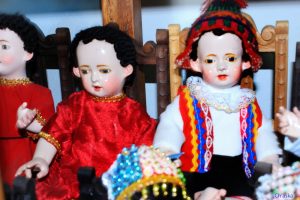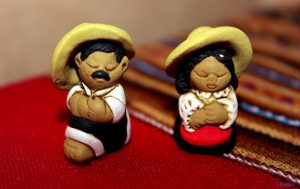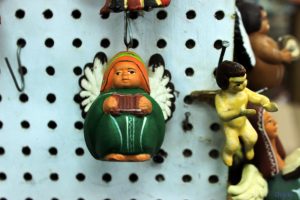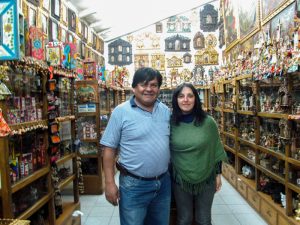Francisco Mendivil, With my Long Neck I Can See You Better.

I got my first Mendívils’ three years ago, on my first trip to Cuzco. In subsequent travels my Buenos Aires shelves became populated with them. With each trip my family and friends–first among them, my mother—would call to remind me to be sure not to forget to buy them more Mendívils with their characteristic elongated necks.
Today, I enjoy spending my soles in their workshop because I know that the people for whom I choose Mendívil’s creations will value these miniatures, the nativity scenes, and those long necks will have lots of meaning.
The creations of the Mendívil family are, at least for me, one of many icons of Cuzco. Their long necks, the angels, the armed angels, and the charming Manuelitos—the Christ Child, filled me such curiosity that I sought answers to their creation.
One beautiful Cuzco afternoon, in the midst of the Inti Raymi festivities, Francisco Mendívil was kind enough to receive me with the openness and kindness that only greatness can give. With the gentleness of a son, now an adult, he shared with me some of his family’s secrets. Even more, he revealed to me something very precious, the mystery behind the langourous long necks.
When Hilario Medívil, Francisco’s father, was a boy, he and his mother, Luisa, faced adversity. They had to develop their family business in order to survive in the city of Cuzco of those years. They were craftsmen, something they inherited from Hilario’s mother’s family.


When he was eight years old, Hilario made his first figures of the Three Wise Men. He gave them an unusual characteristic; their necks were long and extended. His uncle, a very experienced craftsman and maker of religious images, corrected him. He told him that what he had done was bad. Those were not times when a child could contradict his elders’ instructions.
Years passed and Hilario continued his work in Cuzco. One day, because of the magic things of life, a very young woman, almost a child, Georgina Dueñas, crossed his path. In the course of comings and goings, and after overcoming family opposition, their lives joined forever. Together they had a large family.
Hilario developed his craft with Georgina. Their years together were difficult. They had to supplement their earnings from their craft with other jobs in the textile industry since they could not make enough from their art to feed their children who kept coming, one after another.
Nevertheless, Hilario and Georgina continued with their art. Furthermore, they trained various others among the numerous creative craftsmen of today’s Cuzco.

Hilario was an artist and a bohemian. And, he lived both to the fullest. As a result his life was complicated. But it was filled with art and Georgina put up with his doings with unbelievable love and patience. Though they worked together in their workshop, almost without rest, success evaded them. They dared not even dream of it.
One afternoon, two upper crust ladies from Lima roamed the streets of San Blas, the artisan quarter, with boredom. They had seen it all and were unimpressed. An open door in a small passageway caught their attention nevertheless. In it sat the images that Mendívil created. The ladies came up to the door and the family dog announced their arrival with loud barks. Georgina appeared, to answer the question posed by the ladies. “My husband is the one who makes them,” she said with some surprise.
The Mendívil family never imagined that their lives would change forever from that moment. Their new patrons turned out to be Doris Gibson (the owner of the very important news magazine Caretas) and Cecilia Bustamante (the wife of Peru’s famous writer José Marìa Arguedas. They knew how to capture and promote the unique style of Hilario and his wife and disciple, Georgina. As a result, they proposed a show of their work in the Pancho Fierro Gallery of Lima, a prominent art gallery in Peru’s capital city.
The Mendívils undertook a week of travel, without knowing the secrets of the big city nor where they might stay. The first night they slept in a public park, the Parque Universitario, since they had no idea of where else to go. But it did not matter. Their love was strong and with it they could keep themselves warm in the chilly Lima night

Their night of little sleep was worth it, because the next day their images were a great success. They sold all of them.
More fairs and opportunities arrived and, each time, they sold all they brought for the show. Little by little the creations of Hilario and Georgina became icons of Cuzco, as well as of the neighborhood of San Blas. To say San Blas is to say Mendívil now.
Hilario died very young, probably because of his bohemian life and the dissolution that implies. But at his death he knew how important he and his work had become for Cuzco.
At the peak of his popularity he was asked, in an interview, why he elongated the necks of his figures. The explanation was very simple. When he was a child he was quite short, of course. He could not see the llamas that were in the streets of his city. As a result he had to stretch his neck to be able to satisfy his curiosity. By doing so he could see from down below. What was better then, than to build into his figures what he, as a child, could not have: beautiful, long necks to be able to see the llamas.
Neither Hilario nor Georgina are still with us, but their legacy remains with their children. That is another story, one that, of course, will continue.






I would like your help in determining what my 3 kings may be worth, I purchased these about 35 years ago in Pasadena California. Any help would be greatly appreciated. I am sending you a picture.
Thanking You in advance
Bill Garcia
Hi Bill, I do not know if we can be of help since evaluation depends on the market for Mendivil art and that is not something we deal in. My apologies and hopes that you find who can help you. I think you would want to talk to a dealer in folk art and in Peruvian art. Mendivil works certainly are beautiful.
David